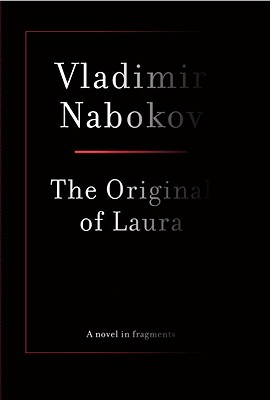The Original of Laura by Vladimir Nabokov;
with an introduction by Dmitri Nabokov
As anyone with a pulse already knows, The Original of Laura should never have been published. Still, as a Nabokov completest, I couldn’t wait to get my hands on it. It is less a book in the usual literary sense—there is no pretense that this is anything but a collection of transcribed note cards—than a book in the sense of an objet d’art. Setting aside the almost total lack of a novel within, The Original of Laura gives as much pleasure as any book I’ve held short of handmade. As a publishing event, it’s quite brilliant; an ardent Nabokov fan would have to get two copies, one to keep intact, and another to take out the perforated index cards to play with.
Where Nabokov’s last published novel, Look at the Harlequins was a send-up of his own autobiography, The Original of Laura is a send-up of his more famous novels, Lolita and Pale Fire. There is a decaying older man (Phillip Wild) and a young woman (Flora, his wife), an embedded literary masterpiece that obsesses the protagonist, and that familiar obsession with death that pervades all of Nabokov’s fiction. Not a surprise, given the subtitle, Dying is Fun.
Indeed, the theme of the projected novel seems to be coming to terms death by coming to own it, and what art has to do with that. Flora’s grandfather is said to die “not from his own commonplace malady, but from the cancer of oblivion invading his once famous pictures.” Flora’s father kills himself but the profits from capturing that daredevil feat on camera catapults his wife to Europe. A would-be stepfather’s own daughter dies offstage (bicycle, truck). Flora’s own mother dies during her graduation, also to be caught in a photograph. There is Wild’s own deliberate experiments in dissolution, stemming perhaps from his disillusion about his wife, and his real death by a sudden heart attack. Laura is killed off by her author, but Flora survives.
The strangest, least familiar, theme in the book isn’t the intertwining of infidelity and death that runs rife through Nabokov, but Phillip Wild’s strange existential experiments. It is a mirror image of the same old fascination with the idea of solipsism, but here world making has turned into self destruction. Phillip Wild is a neurologist, and it seems strange that his own suicide by sheer mental will should be the subject of his research. Moreover, it isn’t clear whether his heart attack that kills him is a botched part of the experiment, or if it just happens to him.
The idea of how that art interacts with life seems to be expressed by a constant shift in perspective. The first chapter is told from the point of view of one of Flora’s paramours, the second is a retrospective about Flora from Wild, and eventually it changes again into Wild in the first person about himself, with intrusions from an omniscient narrator. Perhaps the constant switching of point of view is some sort of reference to Flora’s infidelity, but there really isn’t enough here to begin to decipher what is going on.
It does seem clear, however, that Nabokov had booby-trapped the work, daring his literary executioners to publish the work in spite of his express wishes. In chapter 1, the yet unnamed philanderer (later named Eric) describes sex with Flora:
Only by identifying her with an unwritten, half-written rewritten difficult book could one hope to render at last what contemporary descriptions of intercourse so seldom convey…”
Readers are directed to that book—on a very high shelf in a very bad light—but already as magic exists, and death, and as shall exist.”—which is, of course, what the reader holds in her hands: an unwritten, half-written, difficult book. And one which refers to itself that way, letting the reader wonder if references to the incompleteness of the novel would have made it into the final version.
The Original of Laura is a very obviously incomplete work. For example, there are three separate Chapters five, and then after that the numbering falls completely apart. Publishing it as a set of notecards might have been the only plausible option. As such, the real achievement here is by Chip Kidd, the eminent book designer. He turns what easily might have been an impossible situation into the sort of fun a Nabokov novel should have been.
Reviewed by James Liu
The Original of Laura by Vladimir Nabokov
Alfred E. Knopf, 2009
Cloth, 304 pp, $35.00
ISBN-13: 9780307271891

